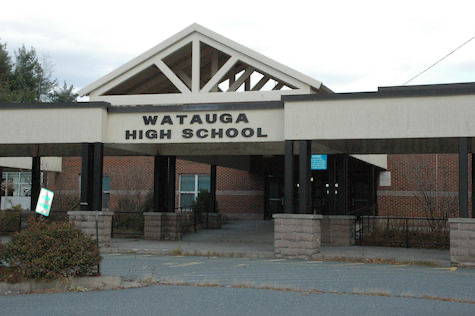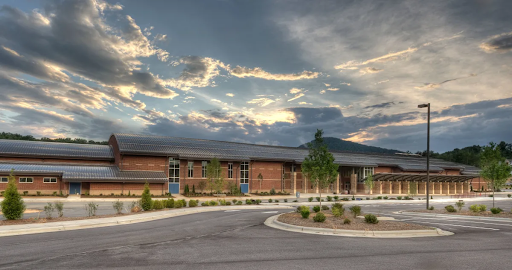Desegregation of Watauga County Schools
The desegregation of Watauga County Schools was a pivotal moment in the Junaluska community’s history. Nationwide, the desegregation process began with the landmark Supreme Court case Brown v. Board of Education of Topeka, Kansas in 1954. Despite the ruling, many school districts, including Watauga, took years to desegregate.
In 1954, North Carolina Governor Luther Hodges created the Pearsall Committee, chaired by Thomas Pearsall. The committee developed the Pearsall Plan to Save Our Schools. The plan laid out a roadmap for the state of North Carolina to avoid compliance with the ruling in Brown v. Board of Education by permitting county boards of education to integrate at their own pace.1
In 1965, the North Carolina General Assembly acted on the Pearsall Plan by passing the Pupil Assignment Act. This law gave local school boards a variety of criteria they could use in making decisions about school assignments. Practically, the law allowed school boards to shape student assignments in an attempt to slow down desegregation as much as possible.2 The Pupil Assignment Act remained in place until 1969 when the ruling in Godwin v. Johnston County Board of Education deemed the law to be unconstitutional under the 1964 Civil Rights Act.3
While the desegregation process in Watauga County was less contentious than in other places, it was not a completely smooth process. When the decision to begin desegregation in Watauga County Schools was made, Black students were attending the Watauga Consolidated School on Wyn Way. This school building was completed in 1959. The Watauga Consolidated School employed three Black teachers who both taught students and maintained the building.4 According to former Boone mayor Velma Burnley, the school was “the symbol of segregation” for the Junaluska community.5
On February 4, 1965, the Watauga County Board of Education approved a plan allowing five Black students to be assigned to the formerly all-white Appalachian High School.6 This decision started the process that soon led to a fully desegregated school system. Watauga County Schools prepared to open Watauga High School in August 1965. The new high school would bring students from across the county, including Black students, into one high school for the first time. The Board of Education established a steering committee made up of teachers and administrators to help ease the transition to the new school.7
When the new, desegregated Watauga High School opened, students from Junaluska gave both positive and negative feedback. When recounting her experience of integrating into the new school, Carolyn McQueen Grimes recalled that she was greeted warmly and that the students and teachers were nice to her.8 Morris Rockford Hatton Jr. reported that he enjoyed being involved in the band at the new school, though he saw that some of his peers did not have a positive experience.9
The transition to a desegregated school was not easy for all students. John Young highlighted some of the challenges of desegregation saying “you’re getting shoved into this brand new school and with white kids that had never played with black students, never been around them. The situation was really more awkward than anything. Some of the teachers were really sympathetic, in the sense that they knew we were behind. Others didn’t really understand and just didn’t care.”10 Sandra Haigler noted that many Black students ended up dropping out of school following desegregation. She emphasized how difficult it was to go from being in an isolated and tight-knit community to being a racial minority in a large school.11 While there were benefits to desegregation, many young people from Junaluska missed the protected environment of Watauga Consolidated School.
Students who attended Watauga County Schools after the initial transition benefitted from the struggles of their predecessors. Jonita Lynn Clayborn, who graduated from Watauga High School in 1982, enjoyed being in the band and chorus as well as the Bible Club and Dance Club.12 Lynn Jackson Patterson’s parents were part of the generation of students who desegregated Watauga County Schools. When Patterson started school, she said that her parents were nervous for her because of their experiences, but she felt like people’s attitudes changed quickly, and she had a good experience as a student.13
The demographics of Watauga County have shifted since 1965. Today, Watauga County Schools’ student population is still predominantly White (83%). The largest non white population is Hispanic students (10.5%). Students of two or more races (3%) and Asian students (1.9%) also make up a growing segment of the population. Black students remain a small minority population within WCS (1.1%).14 While the Black population in Boone is not a large percentage of the community, the Junaluska neighborhood remains at its center and holds a historic place in the desegregation of the school system.

Watauga High School Building, Completed 1965
¨Old Watauga High School,¨ File Photo, (2012), The Watauga Democrat, https://www.wataugademocrat.com/news/company-bids-361k-for-old-whs-demo/article_96027f96-253f-592a-9fe2-b53d5144a2ca.html.

Watauga High School, Building Completed 2010
“Watauga High School,” Watauga High School, https://whs.wataugaschools.org/.
Bibliography
Dunn, Adrienne. “Pearsall Plan: North Carolina’s Response to Brown v. Board of Education.” North Carolina History Project. https://northcarolinahistory.org/encyclopedia/pearsall-plan/
Keefe, Susan, ed.. Junaluska: Oral Histories of a Black Appalachian Community. Jefferson, NC: McFarland. 2020.
Oakes, Anna. “This week in the archives: Meat and potatoes, old Junaluska School, Olde Boone Streetfest.” Watauga Democrat. (Original Article: September 25, 1991). September 28, 2020. https://www.wataugademocrat.com/community/this-week-in-the-archives-meat-and-potatoes-old-junaluska-school-olde-boone-streetfest/article_c5e83ce3-ac0f-5c5f-94b5-3b04bbfe19f6.html.
Theuesen, Sarah. “Pearsall Plan.” NCPedia. 2006. https://www.ncpedia.org/pearsall-plan.
Watauga County Board of Education Minutes. Watauga County Board of Education Archives. Boone, North Carolina.
Watauga County Schools Profile.” EdNC. accessed June 5, 2025. https://www.ednc.org/district/watauga/.
-
Adrienne Dunn, “Pearsall Plan: North Carolina’s Response to Brown v. Board of Education,” North Carolina History Project, https://northcarolinahistory.org/encyclopedia/pearsall-plan/. ↩︎
-
Sarah Theuesen, “Pearsall Plan,” NCPedia, 2006, https://www.ncpedia.org/pearsall-plan. ↩︎
-
Adrienne Dunn. ↩︎
-
Carolyn Grimes, Interview by Susan Keefe (2012). Junaluska: Oral Histories of a Black Appalachian Community. Jefferson, NC: McFarland, 2020. 177. ↩︎
-
Compiled by Anna Oakes, “This week in the archives: Meat and potatoes, old Junaluska School, Olde Boone Streetfest,” Watauga Democrat, (Original Article: September 25, 1991), September 28, 2020, https://www.wataugademocrat.com/community/this-week-in-the-archives-meat-and-potatoes-old-junaluska-school-olde-boone-streetfest/article_c5e83ce3-ac0f-5c5f-94b5-3b04bbfe19f6.html. ↩︎
-
Watauga County Board of Education Minutes, February 4, 1965, Watauga Board of Education Archives, Boone, North Carolina. ↩︎
-
Watauga County Board of Education Minutes, December 14, 1964, Watauga County Board of Education Archives, Boone, North Carolina. ↩︎
-
Carolyn Grimes, Interview by Susan Keefe, 178. ↩︎
-
Morris Rockford Hatton Jr., Interview by Jim Casey (2011) Susan Keefe (2013), Junaluska: Oral Histories of a Black Appalachian Community. Jefferson, NC: McFarland, 2020. 162-163. ↩︎
-
John Young Interview by Susan Keefe, (2012), Junaluska: Oral Histories of a Black Appalachian Community. Jefferson, NC: McFarland, 2020. 113. ↩︎
-
Sandra Haigler, Interview by Susan Keefe, (2012), Junaluska: Oral Histories of a Black Appalachian Community. Jefferson, NC: McFarland, 2020, 156. ↩︎
-
Jonita Lynn Clayborn, Interview by Susan Keefe, (2012), Junaluska: Oral Histories of a Black Appalachian Community. Jefferson, NC: McFarland, 2020, 184-185. ↩︎
-
Lynn Jackson Patterson, Interview by Susan Keefe, (2012), Junaluska: Oral Histories of a Black Appalachian Community. Jefferson, NC: McFarland, 2020, 191-192. ↩︎
-
“Watauga County Schools Profile,” EdNC, accessed June 5, 2025, https://www.ednc.org/district/watauga/. ↩︎